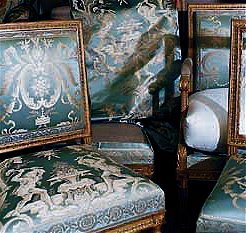 I received my first subscription copy of L'Objet D'Art yesterday. The first true glimpse of civilization - other than the Met - that I've had in New York. There is a magnificent suite of restored Louis Seize fauteiuls, firescreen, prix-deux and bergeres made for Marc-Antoine Thierry de Ville d'Avray. The original gilding has been left in place with retouches but the original silk, which was a Wedgwood Blue colour woven with gold thread, had yellowed and crumbled. The fabric has been meticulously rewoven and the restored suite main be seen on display at the Boston Mueseum of Fine Arts.
I received my first subscription copy of L'Objet D'Art yesterday. The first true glimpse of civilization - other than the Met - that I've had in New York. There is a magnificent suite of restored Louis Seize fauteiuls, firescreen, prix-deux and bergeres made for Marc-Antoine Thierry de Ville d'Avray. The original gilding has been left in place with retouches but the original silk, which was a Wedgwood Blue colour woven with gold thread, had yellowed and crumbled. The fabric has been meticulously rewoven and the restored suite main be seen on display at the Boston Mueseum of Fine Arts.From the Boston Museum of Fine Art's Website (Click the title of this post to take you there.)
The Museum holds the only complete set of eighteenth-century French royal furniture in the United States - prized objects from the MFA’s Swan Collection. In the mid-1790s, Bostonian James Swan, the French government’s sole American purchasing agent, acquired the gilded-wood furni-ture in exchange for necessities such as wheat, rice, tobacco, leather, and naval supplies he procured for the cash-strapped Revolutionary government. He and his wife, Hepzibah, used the furniture in the French-style residence they had built in Dorchester, and the furniture subsequently descended through various branches of the family in New England. The MFA acquired all ten pieces through gifts and bequests made by members of the Swan family between 1921 and 1953. Due to their varied histories, many of the pieces had been reupholstered and had undergone several restorations to the gilded frames; therefore, they differed greatly in appearance.
The ten pieces recently returned from Paris, the last stop in a complicated four-year conservation project. In the process of treating the gilded surfaces and reupholstering the furniture, conservators made startling discoveries about the practices of gilders and upholsterers in late-eighteenth-century France.
The gilded frames of the furniture were conserved in Los Angeles by Cynthia Moyer, an expert in the conservation of gilded surfaces. Next, the textile firm of Tassinari & Chatel, founded in Lyon, France, about 1680, reproduced the silk show fabric and borders, custom-dyeing the silk to match the blue, taupe, and cream colors of the original textile. The reweaving of the finish fabric, from the design of the cartoon (the full-scale drawing of the pattern) to the completion of nearly 220 yards, took approximately nine months.
Declercq Passementiers in the Ile-de-France hand made six different trimmings, including silk gimps, braids, and tassels, for the reupholstery, using eighteenth-century techniques. Finally, upholsterer Rémy Brazet, of the firm of Jacques Brazet in Paris, employed an innovative, non-interventive technique to upholster the furniture. Traditionally, tacks are nailed into the wooden frame to secure the upholstery. However, with repeated reupholsteries tacking causes significant damage and deterioration to the fragile, original seat frames. Brazet instead affixed the horse-hair padding and upholstery fabrics to new drop-in wooden frames. Archival documents and surviving upholstery fragments provided the upholsterers with the evidence needed to re-create the original appearance of the upholstery.
The furniture, made for Marc-Antoine Thierry de Ville d’Avray, the general administrator of the Crown furniture, in 1787, will be on view along with other magnificent works from the Swan Collection, including a pair of gilt-bronze andirons made for Marie-Antoinette. Portraits of James Swan and his wife, painted by Gilbert Stuart, complete this noteworthy installation.
Le meuble de la chambre de Thierry de Ville d'Avray restauré
Le musée des Beaux-Arts de Boston conserve le meuble complet de la chambre de Thierry de Ville d'Avray à l'hôtel du Garde-Meuble de la Couronne, actuel hôtel de la Marine, place de la Concorde à Paris. Chef-d'œuvre du menuisier en siège Jean-Baptiste-Claude Séné et du tapissier Claude-François Capin, seul ensemble de sièges de cette importance aux États-Unis, il est à nouveau présenté dans la nouvelle galerie du musée consacrée au XVIIIe siècle. Sous la conduite de Tracey Albainy, conservateur au musée, il a fait pendant quatre années l'objet d'une restauration exemplaire, confiée, aux États-Unis, à Brian Considine et Cynthia Moyer pour la dorure et, à Paris, à Michel Jamet, ébéniste, aux ateliers Jacques Brazet, tapissiers, pour les châssis et la garniture. Nous présentons ici l'histoire de cet ensemble prestigieux ainsi que les principales étapes de sa restauration qui a remis en cause certaines idées reçues quant à la garniture des sièges Louis XVI.
Auteur : Xavier Bonnet et Michel Jamet
Magazine : L'Objet d'Art n° 376 Page : 62-77
Date : 01/01/2003


2 comments:
The work, that's been done, is amazing, if you want to find out more about Rémy brazet's work, you should visit his website http://www.maisonbrazet.fr/en/
I have indeed visited the website, thanks for the tip. A fascinating man, and amazing work indeed!
Post a Comment